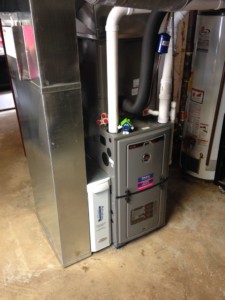As the weather turns cooler and area residents turn up the heat, they also begin to experience issues with their furnaces. While regular maintenance can certainly help reduce your risk of costly repairs or replacements (and we actually have some helpful furnace maintenance tips you can find here!), it may be time to consider replacing your unit if you find yourself face-to-face with a hefty repair bill.
A lot goes into the decision to repair or replace a furnace. Here are some things you should consider before making the decision:
Age of Unit – If your furnace is less than 12 years old and has been well maintained, it’s likely that a repair can fix the problem at hand. Even if you have a unit that’s 12 years or older that hasn’t experienced significant breakdowns, it may be time to consider replacing your unit anyway, and here’s why: If you’re having to shop for a new  unit during an emergency, you typically won’t have the time to make an informed decision or get a second opinion or estimate from another company. This leaves you having to settle for the first estimate you receive which could cause you to spend much more than if you had spent time shopping for various options. Bonus: Arlinghaus offers free second opinions and estimates.
unit during an emergency, you typically won’t have the time to make an informed decision or get a second opinion or estimate from another company. This leaves you having to settle for the first estimate you receive which could cause you to spend much more than if you had spent time shopping for various options. Bonus: Arlinghaus offers free second opinions and estimates.
Frequency of Repairs or Thermostat Issues – Have you been shelling out hundreds of dollars over the past couple of years for numerous repairs on your furnace? If so, it may be more cost-effective to replace the unit altogether. If you notice that your thermostat does not properly reflect the temperature in your home that could be an indicator of a larger issue and might be a sign to replace an older unit.
Energy Efficiency – Over the years, your furnace loses its energy efficiency as it ages, especially if the unit has not been properly maintained. If you notice a big jump in your energy bills, it may be time to say goodbye to your unit for a more energy-efficient model. All of the additional money you’re now putting into your energy bill each month could be used to purchase a newer, more energy-efficient unit.
Potential Carbon Monoxide Leaks – If your unit is an oil-fired model that runs on fuel oil and is emitting a yellow or flickering flame, this could be an indicator of potential carbon monoxide leaks. Soot around the furnace, the absence of a draft up your chimney, excess moisture around the home, or rust on the vent pipe on the outside of the unit could all be signs of a potential issue. Even if you don’t have an oil-fired unit, all units run the risk of developing cracks in the heat exchanges as they age. Be sure that your carbon monoxide detectors are checked regularly and if they go off or your family starts to exhibit flu-like symptoms turn your unit off, exit the home and call a technician immediately. If there is a leak, your unit will need to likely be replaced.
Lack of Humidity in the Air – It’s important to monitor the “relevant” humidity in the home because is directly correlated with comfort and temperatures in the home. During the winter, furnaces pump out dry hot air. However, if moisture is added to the air through a humidifier, temperatures increase slightly in the space – which means thermostats can be turned down leading to a reduction in energy costs. If you notice that the air in your home feels dry or is causing things like cracked woodwork, bloody noses, dry throats or static shocks, then it’s very likely your furnace is to blame. A newer unit can help provide a more comfortable living situation with a built-in humidifier.
Knowing whether to repair or replace a unit can be stressful. The skilled professionals at Arlinghaus provide you with the necessary information you need to make an informed decision that’s best for your family and budget. That’s why we offer free second opinions and estimates, and a number of different finance options to ensure that your home remains a “happy house” all year long. Call us today to schedule your appointment.